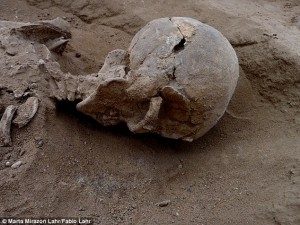10,000-Year-Old Mass Grave Found Near Kenya’s Lake Turkana May be Evidence of Oldest Human War
 Archaeologists say a 10,000 year-old mass grave discovered in East Africa may be the oldest evidence of human warfare.
Archaeologists say a 10,000 year-old mass grave discovered in East Africa may be the oldest evidence of human warfare.
According to a study published in Nature this week, of the 27 skeletons found in the ancient site located near Kenya’s Lake Turkana, at least 10 showed signs of fatal injuries.
Researchers postulate that the remains, which were of prehistoric-hunter gatherers, were deliberately left unburied after their brutal massacre. The haphazard positioning of the remains is cited as evidence that they were not moved after their deaths.
The remains reportedly show unmistakable signs of blunt force trauma from different weapons including arrows and clubs and stone blades. Some skeletons were found to have sustained wounds to the skulls, knees, hands, necks and ribs.
Despite the violent signs of their deaths, two skeletons did not show signs of fatal injuries. The remains of an old man and a woman, who was about six months pregnant, were found with no injury. However, the woman was bounded by her hands and feet. Researchers say it is very likely they too suffered violent deaths.
“These human remains record the intentional killing of a small band of foragers with no deliberate burial, and provide unique evidence that warfare was part of the repertoire of inter-group relations among some prehistoric hunter-gatherers,” lead author Marta Mirazon Lahr said.
Lahr, a paleoanthropologist with the University of Cambridge, said the attack, which killed the prehistoric people, may have been premeditated and organized by a group of foreign raiders. However, it’s impossible to ascertain who and where the assailants were from. The reason for their fatal attack also remains unknown.
Lahr added that the find is evidence that history of humans and violence is very ancient, although the origin of warfare is widely attributed to developing societies.
“Most scholars have considered that warfare emerged as a result of ownership of land, farming and more complex political systems,” Lahr said. “Our findings show that this hypothesis is incorrect, and that intergroup conflict had a much longer history.”
Archaeologists have discovered other ancient sites that showed examples of violence. However, unlike the find in Kenya, the victims were buried.
The site of the ancient massacre is located about a mile from the shores of Lake Turkana, which fossils records shows was home to several animals such as lions, wild dogs, hyenas, zebras, rhinos, gazelles and hippos. The site, which is also a goldmine of archaeological findings, also had a large population of fishes.
“The edge of the lake must have been an amazing place to live- but also dangerous,” Lahr said. “We have also found several fragments of human fossils at other sites with evidence of having been eaten by carnivores.”
Despite the find, scholars are torn about the origins of warfare among human societies.
Photo: Marta Mirazon Lahr/Fable Lahr